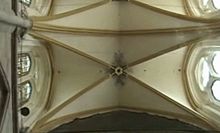Yoke (architecture)
Yoke or pillar yoke is called the center distance between two pillars or pillars in architecture . It is measured from center to center. This is what distinguishes the yoke from the intercolumnium , the clear distance between columns or pillars. The term is generally used in the architecture of pillars and pillars, especially in Greek and Roman architecture as well as in medieval and Islamic architecture .
Church building
In the architecture of church construction , yoke refers to the vault section of a church nave between four supports , often separated by belt arches . A yoke is therefore located as a space compartment between four supports - z. B. the crossing square . You can see the yoke division when you look into the vault of a church nave: The strong diagonal vault ribs extending from the supports are divided into yokes laterally by the walls or by dividing arches and lengthways by belt arches.
Vorchorjoch
Separated by larger sized transverse arches and vaults from the rest by a dome architectural highlighted etc. is in many Roman or baroque the yoke churches before the chorus ; it is known as the “Vorchorjoch”. For larger church buildings with a transept , it is usually identical to the “Vierungsjoch”.
literature
- Christoph Höcker : Metzler Lexicon of Ancient Architecture. Metzler, Stuttgart 2008, ISBN 978-3-476-02294-3 , p. 138 f.


